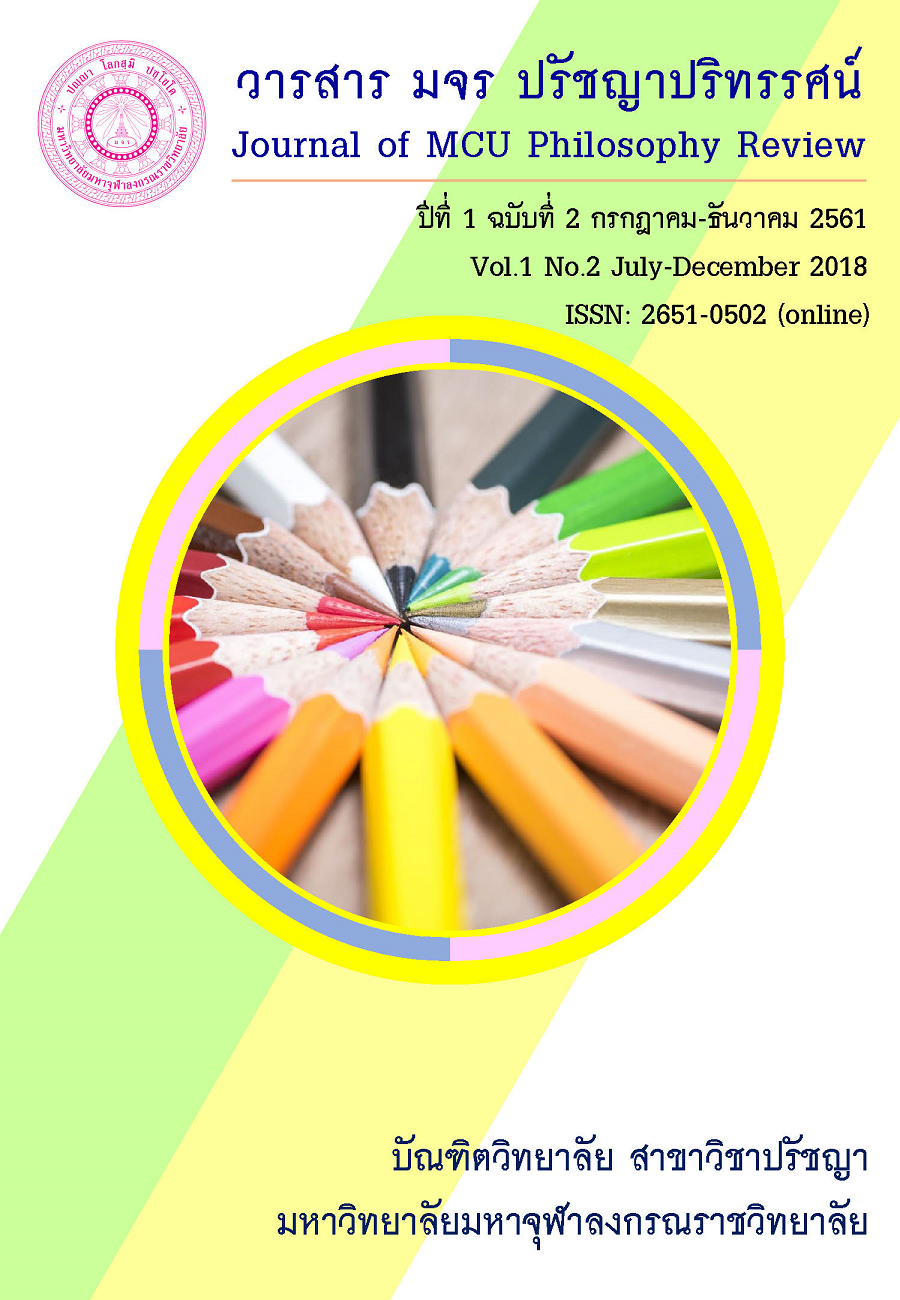The Lotus and Leaning in Concept Buddhist Philosophy
Main Article Content
Abstract
This article entitled to analyze the Lotus and Leaning in Concept Buddhist Philosophy. This is a qualitative research done by studying academic documents. In the research, it was found that the lotus related for the longest time with the Thai way of living. Lotus them appeared in the expressions, language, literature, idioms, proverbs and aphorisms as well as the beliefs in Gods. With regard to the naming, the thais believed that the names relation to lotus would bring them happiness and prosperity. In addition, lotus related not only to the sources of knowledge, but also to nutrition and Thai food which were the cultural heritage of the Nation in Thai society. Lotus its flower in Buddhism, There are 3 groups : Ubon Pathum and Buntharik by compare with learning of four Puggala [four kinds of persons] (1) Ugghatitannu = a person of quick intuition ; the genius ; the intuitive (2) Vipacitannu = a person who understands after a detailed treatment ; the intellectual (3) Neyya = a person who is guidable ; the trainable but (4) Padaparama = a person has just word of the text at most ; an idiot.
Article Details
บทความที่ได้รับการตีพิมพ์เป็นลิขสิทธิ์ของวารสาร มจร ปรัชญาปริทรรศน์
ข้อความในบทความที่ได้รับการตีพิมพ์ในวารสาร ถือเป็นความรับผิดชอบของผู้เขียนบทความ และข้อคิดเห็นนั้นไม่ถือว่าเป็นทัศนะและความรับผิดชอบของกองบรรณาธิการวารสาร มจร ปรัชญาปริทรรศน์
References
พระธรรมปิฎก (ป. อ.ปยุตฺโต).(2543 ก). พจนานุกรมพุทธศาสตร์ ฉบับประมวลธรรม. พิมพ์ครั้งที่ 9. กรุงเทพมหานคร : โรงพิมพ์มหาจุฬาลงกรณราชวิทยาลัย.
พระธรรมปิฎก (ป. อ.ปยุตฺโต). (2543 ข). พุทธธรรม. พิมพ์ครั้งที่ ๙. กรุงเทพมหานคร : โรงพิมพ์บริษัทสหธรรมิก จำกัด.
พระพุทธโฆสาจารย์. (2546). คัมภีร์วิสุทธิมรรค. แปลโดยสมเด็จพระพุฒาจารย์ (อาจ อาสภมหาเถร) และคณะ. พิมพ์ครั้งที่ 4. กรุงเทพมหานคร : บริษัท ประยูรวงศ์พริ้นติ้ง จำกัด.
พระเทพมุนี (วิลาศ ญาณวโร). (2532). โพธิธรรมทีปนี. พิมพ์ครั้งที่ 5. กรุงเทพมหานคร : โรงพิมพ์มิตรสยาม.
พระเทพดิลก. (2543). พระสุตตันตปิฎก ขุททกนิกาย เล่ม 1. พิมพ์ครั้งที่ 2. กรุงเทพมหานคร: โรงพิมพ์มหามกุฏราชวิทยาลัย.
พระวิมลศีลาจารย์. (2496). ดอกบัวกับพระพุทธศาสนา. กรุงเทพ: โรงพิมพ์อักษรนิติ.
พระสัทธัมมโชติกะ ธัมมาจริยะ. (2539). ปรมัตถโชติกะ ปริจเฉทที่ 9 เล่ม 1. กรุงเทพ: มูลนิธิสัทธัมมโชติกะ.
พระสัทธัมมโชติกะ ธัมมาจริยะ. (2539). ปรมัตถโชติกะ มหาอภิธัมมัตถสังคหฎีกา ปริจเฉทที่ 5 เล่ม 1. กรุงเทพมหานคร : มูลนิธิสัทธัมมโชติกะ.
มหาจุฬาลงกรณราชวิทยาลัย. (2535). พระไตรปิฎกภาษาบาลี. ฉบับมหาจุฬาเตปิฏก 2500. กรุงเทพมหานคร : โรงพิมพ์มหาจุฬาลงกรณราชวิทยาลัย.
มหาจุฬาลงกรณราชวิทยาลัย. (2539). พระไตรปิฎกภาษาไทย ฉบับมหาจุฬาลงกรณราชวิทยาลัย. กรุงเทพมหานคร: โรงพิมพ์มหาจุฬาลงกรณราชวิทยาลัย.
มหาจุฬาลงกรณราชวิทยาลัย. (2539). อรรถกถาภาษาบาลี ฉบับมหาจุฬาอฏฺฐกถา. กรุงเทพมหานคร: โรงพิมพ์มหาจุฬาลงกรณราชวิทยาลัย.
มหาจุฬาลงกรณราชวิทยาลัย. (2560).อรรถกถาภาษาไทย ฉบับมหาจุฬาลงกรณราชวิทยาลัย. กรุงเทพมหานคร: โรงพิมพ์มหาจุฬาลงกรณราชวิทยาลัย.
พระอัคควังสเถระ และ พระธรรมโมลี. (2545). สัททนีติสุตต-มาลา คัมภีร์หลักบาลีมหาไวยากรณ์. แปลโดย พระมหานิมิต ธมฺมสาโร ป.ธ. ๙ และ จำรูญ ธรรมดา.กรุงเทพมหานคร : โรงพิมพ์พิทักษ์อักษร.


